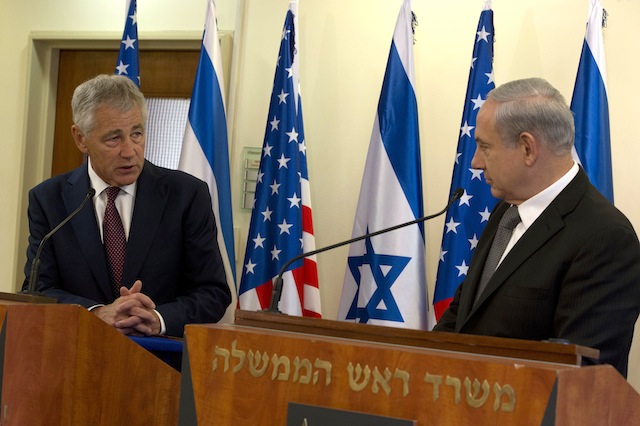by Mitchell Plitnick
US Secretary of Defense Chuck Hagel may have insisted that the latest sale of US arms to Israel sent a strong message to Iran, but the actual message was a bit more restrained. Hagel made a point of emphasizing that the arms sale reaffirmed the close ties between the nations and repeated the Obama Administration’s mantra that Israel has the right to defend itself. The actual sale, though, gave the US another lever of control over a potential Israeli attack.
For Israel, the sale was a double-edged sword. The new equipment from the US does make it easier for Israel to attack Iran. Anti-radiation missiles disrupt anti-aircraft systems, and the new refueling jets modernize and expand Israel’s existing arsenal of such planes.
What they don’t do is give Israel the means to carry out an attack on Iran’s key nuclear facility at Fordo. For that, Israel needs the prize it has been seeking from the US: the new Massive Ordnance Penetrator (MOP), a “super bunker-buster” bomb weighing fifteen tons that’s capable of penetrating ten times as much concrete as previous models. With the Fordo site located some 300 feet underground, the MOP is the only bomb that might be able to impact the facility.
It is by no means certain that even the MOP could knock the Fordo facility out, but without that bomb, Israel cannot realistically try, short of a massive ground invasion. And even with the bomb itself, Israel would still need a plane to deliver the 15-ton explosive. Only a B-2 bomber can do that operationally and Israel currently does not have one.
The message being sent to Israel becomes clearer in light of an interesting event in the Senate on April 17. Senate Resolution 65 was an AIPAC-Sponsored bill that included a clause which committed the United States to supporting Israel if it attacked Iran. Usually, such AIPAC bills slide through the Senate and quickly reach an up or down vote on the floor. This one was marked up in the Foreign Relations Committee.
The markup was significant. Though it still commits the US to supporting Israel against Iran, it is not a simple green light for an Israeli attack with a rubber stamp on US involvement. It refers to legitimate self-defense, rather than just any Israeli decision to attack. The US can decide whether an Israeli act constitutes “legitimate self-defense”. The bill also makes clear that such defense refers only to Iranian nuclear targets. The markup also clarifies that any US support for an Israeli attack must conform to US law, including further Congressional authorization for any US action.
It’s still a problematic bill for many reasons, but it doesn’t create an automatic path for Israel to force the United States into a war with Iran. The fact that this AIPAC bill even went to a markup is unusual and says a lot. Combined with the public refusal to sell Israel the MOP — which gives the strong impression that the US is not even considering such a sale — an image of an Obama Administration determined to have a much firmer grip on its Iran policy during its second term emerges. Previously they felt too easily pressured by Israel’s and Prime Minister Benjamin Netanyahu’s grip on Congress and public opinion.
The US did enhance Israel’s ability to attack Iran, but it continues to guard the key to making such a mission successful in terms of setting back the Iranian nuclear program. In this way, the Obama Administration has stood by its principle that Israel has the right to defend itself, while maintaining its control over critical decisions regarding Iran. And Congress did not end up thwarting the administration’s designs.
By making it clear that Israel is free to make its own decisions — and that the US will also do so — Obama hopes to blunt Netanyahu’s ability to mount the sort of pressure he did last time. Given that Israel seems to be publicly playing along with these moves, the plan may be working, at least for now.
While a lot of attention has been paid to the continuing US refusal to provide Israel with the massive bunker buster bomb, much of the strategy at play in this sale was revealed in a piece of equipment Israel was able to buy. The V-22 Osprey combines the speed and range of a plane with the vertical maneuverability of a helicopter. Its main use is as a personnel and supplies carrier, though it can also be equipped with surveillance devices.
Israel is the first country the US has sold the V-22 to. Its ability to land almost anywhere it can fit and hover over a given point combines with its range to significantly increase areas in which Israel can consider infiltration operations. It’s possible that some sort of commando operation into Iran could be augmented by the V-22, but it wouldn’t be a direct flight; Iran lies at the extreme edge of the V-22’s range. It would have to be carried there on a ship.
More likely, the V-22 is meant for use in the more immediate neighborhood. It will enable Israel, according to one anonymous Israeli colonel, to “…be able to carry out operations that we never imagined that one of our planes could execute. If we purchase the plane, our ranges of activity will dramatically change and we’ll be able to reach points we’ve never even dreamed of.”
The V-22 could be used to get commandos in and out of areas quickly, enabling Israel to strike specific targets deep inside Arab countries. It would enhance their ability to launch operations at selected militant camps or people and get their own soldiers in and out quickly.
Although the V-22 is likely to be sold to other US allies soon, selling it to Israel before any other country was clearly meant to further the charm offensive that President Obama and Secretary of State John Kerry have been pushing with their visits to the region recently. But underlying that is a tie-in with the efforts to mend the breach between Israel and Turkey.
The hope seems to be that Turkey and Israel can work together to enhance stability in the region as the dominant military powers. That is a bit of a stretch, it’s true, but the US wants to scale back its direct involvement in the region, and this is one way of doing that. It could work. In the worst and more likely case, the US will have enhanced Israel’s ability to strike at unfriendly groups within increasingly tumultuous Arab countries. That keeps Netanyahu happy and is the sort of activity that the US has generally wanted Israel to engage in, despite sometimes explosive consequences.
Photo: Secretary of Defense Chuck Hagel gives his opening remarks during a joint media availability with Israeli Prime Minister Benjamin Netanyahu before a meeting in Jerusalem, Israel, on April 23, 2013. DoD photo by Erin A. Kirk-Cuomo.






Wow. Normally I find LobeLob pretty sharp on these things, but this “mixed message” bit is utter nonsense. Pretty much every weapon the US “sold” to Israel in this round was an offensive system designed purely for power projection. The sale effectively acknowledges that Israel has no real defensive needs, and both the US and Israel wish to ensure that Israel can act as regional hegemon, intervening in affairs anywhere. The fact that the US did not ALSO give Israel a bomb that none of its planes can carry is indicative of precisely nothing (except maybe a basic knowledge of physics), especially considering the large number of bunker buster bombs the US has given Israel in recent years.
As for the AIPAC markup, it’s not terribly meaningless. AIPAC asked Congress for a huge give (a blank check), and got almost everything they asked for, except where the request impacted Congressional privilege. Not exactly a surprising or meaningful change.
Agreed, there is no “mixed message.” If there is an attack on Iran, it is likely that it will be launched by the US with Israel told to sit on the sidelines although, as was the war on Iraq, it will done on Israel’s behalf with US B-2 bombers, each of which cost the US taxpayer $2 billion (sic) each, dropping the 15 ton bunker busters.
In fact, Obama did give Israel a smaller version of the bunker busters shortly after he came into office, something that George W had refused to do.
Re the V-22 Osprey, instead of referring vaguely to Israel being able to use them in “Arab countries,” he should have spelled out the country in which Israel would be most likely to use it, namely Lebanon, in a rematch against Hezbollah, which it was unable to beat in 2006 but has apparently been weakened (in Israel’s eyes) as the result of its support for the Assad regime which for obvious geopolitical reasons it was obliged to do.